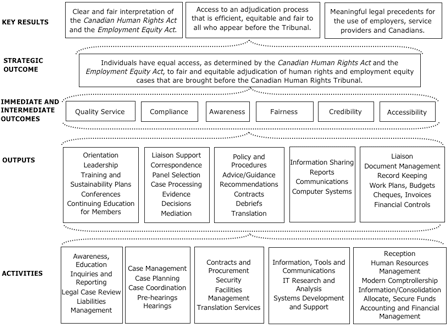Common menu bar links
Breadcrumb Trail
ARCHIVED - Canadian Human Rights Tribunal
 This page has been archived.
This page has been archived.
Archived Content
Information identified as archived on the Web is for reference, research or recordkeeping purposes. It has not been altered or updated after the date of archiving. Web pages that are archived on the Web are not subject to the Government of Canada Web Standards. As per the Communications Policy of the Government of Canada, you can request alternate formats on the "Contact Us" page.
Section 2 Analysis of Program Activities by Strategic Outcome
2.1 Analysis by Program Activity
The Tribunal’s one program activity, together with its internal services activities, achieve the strategic outcome and results for Canadians as shown in the logic model (Figure 2.1).
Program Activity: Hearings of Complaints before the Tribunal
| 2008–09 | 2009–10 | 2010–11 |
|---|---|---|
| 4.4 | 4.4 | 4.4 |
| 2008–09 | 2009–10 | 2010–11 |
|---|---|---|
| 26 | 26 | 26 |
Description
Results
- Clear and fair interpretation of the Canadian Human Rights Act and the Employment Equity Act.
- Access to an adjudication process that is efficient, equitable and fair to all who appear before the Tribunal.
- Meaningful legal precedents for the use of employers, service providers and Canadians.
This program activity will action all the priorities identified in Section 1.
Performance Indicators
- Tribunal decisions/rulings
- Timeliness of initiating inquiry process
- Number of judicial reviews overturned/upheld
- Percentage of cases commenced within timelines
- Percentage of cases completed within timelines

2.2 Operating Environment
From 1996 to 2002, the Canadian Human Rights Commission was referring 44 human rights complaints each year on average. In 2003, there was a dramatic rise in the number of new case files opened, to 130, with a further increase to 139 in 2004. The number of case files opened at the Tribunal decreased slightly in 2005, to 99. Seventy case files were opened in 2006 and total complaint referrals for 2007 is estimated at 75.
Based on advice from Commission representatives, the Tribunal is anticipating the volume of human rights complaints will continue to approach pre-2003 levels over the next few years. However, with 90 case files active before the Tribunal at time of publication, the Tribunal continues to deal with a very heavy workload.
The Tribunal is also working on several important horizontal government initiatives, such as strengthening its accountability framework and its information management capacity, planning for internal audit and evaluation policy implementation, and developing measures to enhance human resources management in the context of public service renewal.
With its very limited resources, the Tribunal anticipates some daunting challenges over the next three fiscal years. To meet these challenges, the Tribunal plans a combination of operational and corporate strategies. The Tribunal’s introduction in 2005 of a case management system (for closely monitoring the pre-hearing phase of inquiries), already noted in Priority 1, and the implementation of the Tribunal Toolkit (an automated case management system) are expected to help address the risks flowing from the Tribunal’s workload challenges. The measures being taken to strengthen the Tribunal’s human resources management capacity, as described in Priority 2, will also help by enabling the Tribunal to put in place retention, knowledge transfer and succession planning as tools for ensuring the continuity of the expertise needed for addressing the workload risk.
The Tribunal has adopted a risk management approach that is integrated with its business planning process. This forward-looking approach broadens the management dimensions of leadership, innovation, probity, transparency and accountability at the Tribunal, which might otherwise be constrained by the nature of the Tribunal’s single program environment — conducting hearings.
Micro-agencies, such as the Tribunal, typically struggle with the additional resource demands posed by resource-intensive, yet necessary, horizontal government initiatives. In 2008–09 and beyond, the Tribunal will also continue to seek out opportunities for benefiting from both new technologies and interdepartmental collaborations. In this way, we believe that the Tribunal will be well positioned to not only meet its mandate for conducting inquiries in a fair and timely manner, but also mitigate the pressures of limited resources for achieving broader government-wide outcomes.
